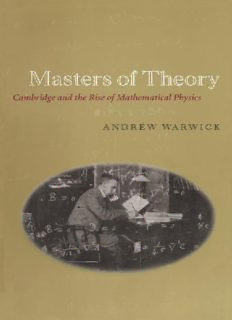
Masters of Theory: Cambridge and the Rise of Mathematical Physics PDF
Preview Masters of Theory: Cambridge and the Rise of Mathematical Physics
Masters of Theory Masters of Theory Cambridge and the Rise of Mathematical Physics ANDREW WARWICK The University of Chicago Press Chicago and London Andrew Warwick is senior lecturer in the history of science at Imperial College, Lon- don. He is coeditor ofTeaching the History of ScienceandHistories of the Electron:The Birth of Microphysics. The University of Chicago Press, Chicago 60637 The University of Chicago Press, Ltd., London © 2003 by The University of Chicago All rights reserved. Published 2003 Printed in the United States of America 12 11 10 09 08 07 06 05 04 03 1 2 3 4 5 isbn:0-226-87374-9 (cloth) isbn:0-226-87375-7 (paper) Library of Congress Cataloging-in-Publication Data Warwick, Andrew. Masters of theory : Cambridge and the rise of mathematical physics / Andrew Warwick. p. cm. Includes bibliographical references and index. isbn0-226-87374-9 (cloth : alk. paper) — isbn0-226-87375-7 (pbk : alk. paper) 1. Mathematical physics—History—19th century. 2. University of Cambridge—History—19th century. I. Title. qc19.6 .w37 2003 530.15(cid:2)09426(cid:2)59(cid:2)09034—dc21 2002153732 (cid:2)(cid:3) The paper used in this publication meets the minimum requirements of the American National Standard for Information Sciences—Permanence of Paper for Printed Library Materials, ansi z39.48-1992. Contents List of Illustrations (cid:2) vii Preface and Acknowledgments (cid:2) ix Note on Conventions and Sources (cid:2) xiii 1 Writing a Pedagogical History of Mathematical Physics (cid:2) 1 2 The Reform Coach Teaching Mixed Mathematics in Georgian and Victorian Cambridge (cid:2) 49 3 A Mathematical World on Paper The Material Culture and Practice- Ladenness of Mixed Mathematics (cid:2) 114 4 Exercising the Student Body Mathematics, Manliness, and Athleticism (cid:2) 176 5 Routh’s Men Coaching, Research, and the Reform of Public Teaching (cid:2) 227 6 Making Sense of Maxwell’s Treatise on Electricity and Magnetism in Mid-Victorian Cambridge (cid:2) 286 7 Joseph Larmor, the Electronic Theory of Matter, and the Principle of Relativity (cid:2) 357 8 Transforming the Field The Cambridge Reception of Einstein’s Special Theory of Relativity (cid:2) 399 9 Through the Convex Looking Glass A. S. Eddington and the Cambridge Reception of Einstein’s General Theory of Relativity (cid:2) 443 Epilogue: Training, Continuity, and Change (cid:2) 501 Appendix A: Coaching Success, 1865–1909 (cid:2) 512 Appendix B: Coaching Lineage, 1865–1909 (cid:2) 524 Bibliography (cid:2) 527 Index (cid:2) 549 Illustrations 1.1. Derivation of the Poynting Vector 5 1.2. Poynting’s 1876 Examination Script (investigation) 19 1.3. Poynting’s 1876 Examination Script (problem) 20 1.4. Pages from Newton’s copy of Barrow’s 1655 Latin edition of Euclid’s Elements 31 2.1. Cambridge University Senate House 54 2.2. William Hopkins 81 2.3. Title Page of J. M. F. Wright’sThe Private Tutor 83 2.4. The “Star of Cambridge” Stagecoach 91 2.5. A College Lecture 93 3.1. Smith’s Prize Questions 121 3.2. A Disputation 123 3.3. Written Examination in Trinity College 124 3.4. Examination Script by William Garnett 165 4.1. “Keeping an Exercise” 193 4.2. Boat Races on the river Cam, 1837 195 4.3. “Training” 196 4.4. St. John’s College Rugby Team, 1881 199 4.5. The Order of Merit in theTimesnewspaper, 1909 203 4.6. Reading the Order of Merit 204 4.7. Presentation of the Senior Wrangler 207 4.8. Ceremony of the Wooden Spoon 209 vii viii illustrations 4.9. Parading the Wooden Spoon outside the Senate House 210 4.10. The Trinity First Boat 220 5.1. Edward John Routh 232 5.2. Syllabus of the Mathematical Tripos, 1873 239 5.3. The Senior Wrangler in his Rooms 245 5.4. Robert Rumsey Webb 248 5.5. Robert Webb’s Coaching Notes 250 5.6. Francis S. Macaulay 259 5.7. Title Page of Wolstenholme’sMathematical Problems 262 5.8. Professorial and Intercollegiate Lectures in Mathematics, 1880–1881 268 5.9. Robert Herman 283 6.1. Pedagogical Geography of Mid-Victorian Cambridge 290 6.2. Routh’s Lecture Notes on Electrostatics 308 6.3. Examination Script by George Pitt 312 6.4. Examination Script by Joseph Ward 314 6.5. Routh’s Team for the Mathematical Tripos of 1880 316 6.6. W. D. Niven 318 6.7. Examination Question, 1886 341 7.1. A Torchlight Procession in Belfast 365 7.2. Tripos Questions, 1901 and 1902 378 7.3. Jeans’sMathematical Theory,Articles 257, 258 383 8.1. Ebenezer Cunningham 410 8.2. Harry Bateman, P. E. Marrack, and Hilda Hudson 417 8.3. Jeans’sMathematical Theory,Articles 226, 227 419 8.4. Jeans’sMathematical Theory,Articles 231, 232 420 8.5. Lecture notes by L. H. Thomas 438 9.1. A. S. Eddington (1904) 450 9.2. Alice through the Convex Looking Glass 466 9.3. Lecture notes by L. H. Thomas 481 9.4. Tripos Problems, 1927 and 1929 488 Preface and Acknowledgments This study offers a new account of the rise of modern mathematical physics. The history of the mathematical sciences has until recently played a rela- tively minor role in the development of social and cultural studies of sci- ence. As an eminent historian in this field remarked to me a few years ago, the project of writing a cultural history of mathematical physics sounded to many like a contradiction in terms. Taking Cambridge University as my ex- ample, I contend in this study that mathematical physics has a necessarily rich culture which is most effectively made visible through the history of training, the mechanism by which that culture has been reproduced and ex- panded for more than two hundred years. We tend to think of “theories” as collections of propositions or fundamental mathematical equations, but this is how they appear to those who have already mastered the physicist’s craft. It takes special aptitude and more than a decade’s education to make human beings who can see a theory in a jumble of mathematical squiggles, and I am interested in how that shared vision is produced. My approach is naturalistic in that it explores theory not in terms of method or logic but through the experience of the student struggling to be- come its master. Nor do I treat theorizing as a uniquely cerebral process. Historiansofexperimentnowspeakroutinelyofmachines,technicians,and embodied practical skills, but what of the material technology and skilled practices of theoreticians? Cambridge undergraduates in the late eighteenth ix
Description: